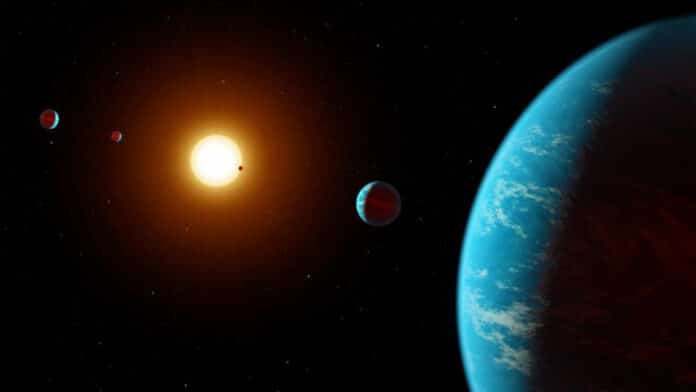Multi-planetary systems are especially valuable because they shared the same host star and were formed by the same accretion disc. The properties of multi-planetary systems have been used to constrain planet formation and evolution models.
A new study suggests multi-planetary systems appear to be less similar in mass than in radius. However, a larger sample of multi-planetary systems with well-characterized mass and radius must confirm this result and uncover additional correlations.
While observing the star system HD 23472, a team of scientists led by Instituto de Astrofísica e Ciências do Espaço (IA) discovered three super-earths and two super-mercuries. This last type of exoplanet is still very rare – counting these two, there are only eight known super-mercuries. The discovery offers clues about how planets like Mercury are formed.
For the study, scientists used the ESPRESSO1 spectrograph (ESO). Scientists mainly wanted to characterize the composition of small planets and understand how it changes with the planet’s position, temperature, and stellar properties. They wanted to study the transition between having or not having an atmosphere, which could be related to the atmosphere’s evaporation due to the star’s irradiation.
Susana Barros (IA & Dep. de Física e Astronomia – Faculdade de Ciências da Universidade do Porto) said, “The team found that this system is composed of three super-Earths with a significant atmosphere and surprisingly two Super-Mercuries, which are the closest planets to the star.”
Three of the five planets in the HD 23472 system are lighter in mass than Earth. These exoplanets rank among the lightest, with their masses determined using the radial velocity method. This was only made feasible by the extremely high precision of ESPRESSO, housed in the Very Large Telescope (VLT) of the European Southern Observatory (ESO) in Chile. And the crew was inspired to do more by discovering not one but two super-mercuries.
Barros adds: “For the first time, we have discovered a system with two super-mercuries. This allows us to obtain clues about how these planets were formed, which could help us exclude some possibilities. For example, if an impact large enough to create a Super-Mercury is already very unlikely, two giant impacts in the same system seem very improbable. We still don’t know how these planets are formed, but it appears to be connected to the composition of the parent star. This new system can help us find out.”
Member of the team Olivier Demangeon (IA & DFA-FCUP), comments: “Understanding how these two super-Mercuries have formed will require further characterization of the composition of these planets. As these planets have radii smaller than the Earth, current instrumentation does not have the sensitivity to probe the composition of their surface or the existence and composition of a potential atmosphere. The future Extremely Large Telescope (ELT) and its first generation high-resolution spectrograph ANDES7 will, for the first time, provide both the required sensitivity and precision to attempt such observations.”
Barros said, “The existence of the atmosphere gives us insight into the formation and evolution of the system and also has implications on the habitability of planets. I would like to extend this study to longer period planets with a more amenable temperature.”
Journal Reference:
- S. C. C Barros, O. D. S. Demangeon et al. HD 23472: a multi-planetary system with three super-Earths and two potential super-Mercuries★, ★★. Astronomy & Astrophysics, DOI: 10.1051/0004-6361/202244293
